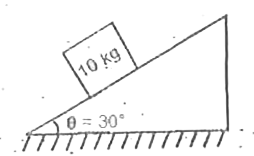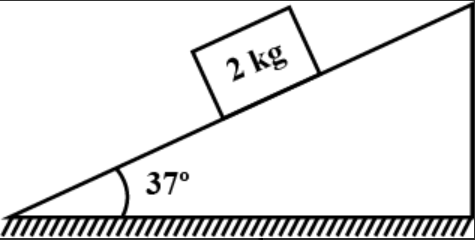A block of mass m rests on a fixed incline plane of inclination θ with horizontal Assume friction is large enough to make the block stationary. Then choose correct alternative (s)
Maximum value of horizontal component of friction is mg
angle θ at which horizontal component of friction is maximum is π4
Maximum value of horizontal component of friction is mg2
Angle θ at which horizontal component of friction is maximum is π3
The correct Answer is:B, C
To solve the problem, we need to analyze the forces acting on the block resting on the inclined plane. Let's go through the steps systematically:
Step 1: Identify the Forces Acting on the Block
The forces acting on the block are:
- The weight of the block, mg, acting vertically downward.
- The normal force N acting perpendicular to the surface of the incline.
- The frictional force F acting parallel to the incline, opposing the motion of the block.
Step 2: Resolve the Weight into Components
The weight mg can be resolved into two components:
- The component parallel to the incline: mgsinθ
- The component perpendicular to the incline: mgcosθ
Step 3: Set Up the Equilibrium Condition
Since the block is stationary, the net force acting on it must be zero. Therefore, the frictional force must balance the component of the weight acting down the incline:
F=mgsinθ(1)
Step 4: Determine the Horizontal Component of the Frictional Force
The frictional force F can also be resolved into horizontal and vertical components. The horizontal component FH can be expressed as:
FH=Fcosθ
Substituting equation (1) into this, we get:
FH=(mgsinθ)cosθ
Using the trigonometric identity sin2θ=2sinθcosθ, we can rewrite this as:
FH=mg2sin2θ(2)
Step 5: Find the Maximum Horizontal Component of Friction
To find the maximum horizontal component of friction, we need to maximize sin2θ. The maximum value of sin2θ is 1, which occurs when:
2θ=90∘⇒θ=45∘
Thus, substituting this into equation (2):
FmaxH=mg2⋅1=mg2
Step 6: Conclusion
The maximum horizontal component of friction is mg2, and this occurs at an angle θ=45∘.
Final Answers
- The maximum horizontal component of friction is mg2.
- The angle at which this maximum occurs is 45∘.
---
The forces acting on the block are:
- The weight of the block, mg, acting vertically downward.
- The normal force N acting perpendicular to the surface of the incline.
- The frictional force F acting parallel to the incline, opposing the motion of the block.
The weight mg can be resolved into two components:
- The component parallel to the incline: mgsinθ
- The component perpendicular to the incline: mgcosθ
Since the block is stationary, the net force acting on it must be zero. Therefore, the frictional force must balance the component of the weight acting down the incline:
F=mgsinθ(1)
The frictional force F can also be resolved into horizontal and vertical components. The horizontal component FH can be expressed as:
FH=Fcosθ
Substituting equation (1) into this, we get:
FH=(mgsinθ)cosθ
Using the trigonometric identity sin2θ=2sinθcosθ, we can rewrite this as:
FH=mg2sin2θ(2)
To find the maximum horizontal component of friction, we need to maximize sin2θ. The maximum value of sin2θ is 1, which occurs when:
2θ=90∘⇒θ=45∘
Thus, substituting this into equation (2):
FmaxH=mg2⋅1=mg2
The maximum horizontal component of friction is mg2, and this occurs at an angle θ=45∘.
- The maximum horizontal component of friction is mg2.
- The angle at which this maximum occurs is 45∘.
Similar Questions
A block of mass m is placed on a smooth inclined plane of inclination θ with the horizontal. The force exerted by the plane on the block has a magnitude
View SolutionA block of mass m is placed on a smooth inclined plane of inclination θ with the horizontal. The force exerted by the plane on the block has a magnitude
View SolutionA block of mass m is kept on an inclined plane is angle inclination θ(<ϕ), where ϕ= angle of friction. Then :
 View Solution
View SolutionA horizontal force F is applied to a block of mass m on a smooth fixed inclined plane of inclination θ to the horizontal as shown in the figure. Resultant force on the block up the plane is:
 View Solution
View SolutionA block of mass m moves with constant speed down the inclined plane of inclination θ. Find the coefficient of kinetic friction.
 View Solution
View SolutionA block of weight 1 N rests on a inclined plane of inclination θ with the horizontal. The coefficient of friction between the block and the inclined plane is μ. The minimum force that has to be applied parallel to the inclined plane to make the body just move up the plane is
View SolutionA block of mass m slides down an inclined plane of inclination θ with uniform speed. The coefficient of friction between the block and the plane is μ. The contact force between the block and the plane is
View SolutionA block of mass 10 kg is kept on a fixed rough (μ=0.8) inclined plane of angle of inclination 30∘. The frictional force acting on the block is
 View Solution
View SolutionA block of mass 2 kg rests on an inclined plane of inclination angle 37∘ , then calculate the force of friction acting on the block [ take g = 10m/s2)
 View Solution
View SolutionA block of mass m is at rest on a rough inclined plane of angle of inclination θ. If coefficient of friction between the block and the inclined plane is μ, then the minimum value of force along the plane required to move the block on the plane is
View Solution

